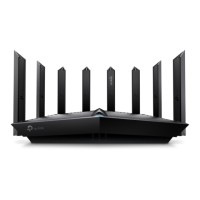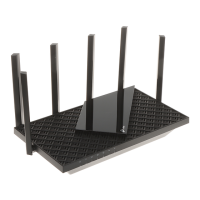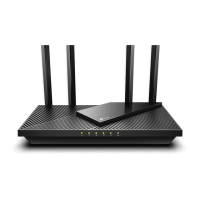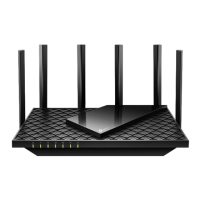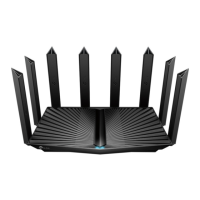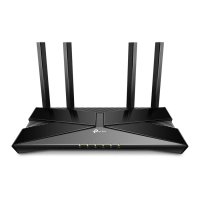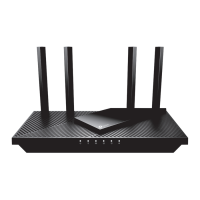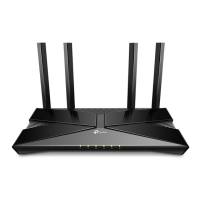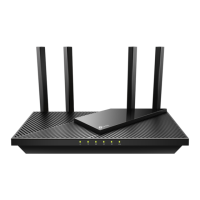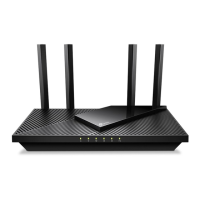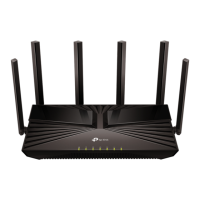Do you have a question about the TP-Link Archer AXE5400 and is the answer not in the manual?
Explains the conventions used in the guide for clarity and understanding.
Provides links to download software, find specifications, and contact support.
Details the features and benefits of the AXE5400 Tri-Band Wi-Fi 6E Router.
Describes the physical appearance and LED indicators for router status.
Guidelines for optimal placement of the router for performance and safety.
Step-by-step instructions for connecting the router to your modem and power.
Instructions on how to log in to the router's web management page.
Guide to using the wizard for a fast and easy internet connection setup.
Steps for manually configuring internet connection types like Dynamic IP, PPPoE.
Configuring the router for IPv6 internet service provided by your ISP.
Steps to register, change, and manage TP-Link IDs for cloud management.
Using the Tether app for remote monitoring and management of your router.
Customizing Wi-Fi network names (SSIDs), passwords, and security options.
Configuring advanced wireless features like WMM, AP Isolation, and Airtime Fairness.
Setting up a separate wireless network for Internet of Things devices.
Steps to set up a separate Wi-Fi network for guests.
Configuring guest network permissions, bandwidth control, and effective time.
Visualizing device connectivity and managing general network settings.
Viewing connected clients, blocking devices, and limiting their network speeds.
Utilizing features like Network Analysis, IoT Protection, and Intrusion Prevention.
Setting restrictions on internet access for family members.
Steps to add TP-Link routers or extenders to create an EasyMesh network.
Viewing and managing devices within the EasyMesh network.
Configuring SPI Firewall to validate traffic and protect against attacks.
Blocking or allowing specific devices to access the network via Blacklist/Whitelist.
Binding IP to MAC addresses to prevent ARP spoofing and attacks.
Isolating vulnerable devices to protect the network from infection.
Sharing local resources on the internet by forwarding specific ports.
Opening external ports dynamically for applications like online games.
Making a PC a DMZ host for unlimited bidirectional communication.
Configuring the router as an OpenVPN server for remote access.
Configuring the router as a PPTP VPN server for remote access.
Setting up WireGuard VPN server for secure and fast remote access.
Configuring the router as a VPN client to access remote VPN servers.
Modifying the router's LAN IP address and subnet mask.
Configuring DHCP server settings and reserving IP addresses for devices.
Configuring DDNS to access the router remotely using a domain name.
Instructions for auto and online firmware updates.
Backing up and restoring router configuration settings.
Steps to change the router's web management login password.
Configuring access controls for local and remote management of the router.
Saving system logs and using diagnostic tools for troubleshooting.
Steps to retrieve or reset the wireless password if forgotten.
Troubleshooting steps for issues logging into the router's web management page.
Solutions for not being able to access the internet after configuration.
Troubleshooting steps for wireless network discovery and connection issues.
Explains the conventions used in the guide for clarity and understanding.
Provides links to download software, find specifications, and contact support.
Details the features and benefits of the AXE5400 Tri-Band Wi-Fi 6E Router.
Describes the physical appearance and LED indicators for router status.
Guidelines for optimal placement of the router for performance and safety.
Step-by-step instructions for connecting the router to your modem and power.
Instructions on how to log in to the router's web management page.
Guide to using the wizard for a fast and easy internet connection setup.
Steps for manually configuring internet connection types like Dynamic IP, PPPoE.
Configuring the router for IPv6 internet service provided by your ISP.
Steps to register, change, and manage TP-Link IDs for cloud management.
Using the Tether app for remote monitoring and management of your router.
Customizing Wi-Fi network names (SSIDs), passwords, and security options.
Configuring advanced wireless features like WMM, AP Isolation, and Airtime Fairness.
Setting up a separate wireless network for Internet of Things devices.
Steps to set up a separate Wi-Fi network for guests.
Configuring guest network permissions, bandwidth control, and effective time.
Visualizing device connectivity and managing general network settings.
Viewing connected clients, blocking devices, and limiting their network speeds.
Utilizing features like Network Analysis, IoT Protection, and Intrusion Prevention.
Setting restrictions on internet access for family members.
Steps to add TP-Link routers or extenders to create an EasyMesh network.
Viewing and managing devices within the EasyMesh network.
Configuring SPI Firewall to validate traffic and protect against attacks.
Blocking or allowing specific devices to access the network via Blacklist/Whitelist.
Binding IP to MAC addresses to prevent ARP spoofing and attacks.
Isolating vulnerable devices to protect the network from infection.
Sharing local resources on the internet by forwarding specific ports.
Opening external ports dynamically for applications like online games.
Making a PC a DMZ host for unlimited bidirectional communication.
Configuring the router as an OpenVPN server for remote access.
Configuring the router as a PPTP VPN server for remote access.
Setting up WireGuard VPN server for secure and fast remote access.
Configuring the router as a VPN client to access remote VPN servers.
Modifying the router's LAN IP address and subnet mask.
Configuring DHCP server settings and reserving IP addresses for devices.
Configuring DDNS to access the router remotely using a domain name.
Instructions for auto and online firmware updates.
Backing up and restoring router configuration settings.
Steps to change the router's web management login password.
Configuring access controls for local and remote management of the router.
Saving system logs and using diagnostic tools for troubleshooting.
Steps to retrieve or reset the wireless password if forgotten.
Troubleshooting steps for issues logging into the router's web management page.
Solutions for not being able to access the internet after configuration.
Troubleshooting steps for wireless network discovery and connection issues.
| Wi-Fi Standard | Wi-Fi 6E (802.11ax) |
|---|---|
| Frequency Bands | 2.4 GHz, 5 GHz, 6 GHz |
| Maximum Wi-Fi Speed | 5400 Mbps |
| Ethernet Ports | 1x 2.5 Gbps WAN/LAN port, 4x Gigabit LAN ports |
| USB Ports | 1x USB 3.0 port |
| Antenna Type | 6x External Antennas |
| Processor | 1.5 GHz Quad-Core CPU |
| Security | WPA3 |
| Memory | 128 MB Flash, 512 MB RAM |
